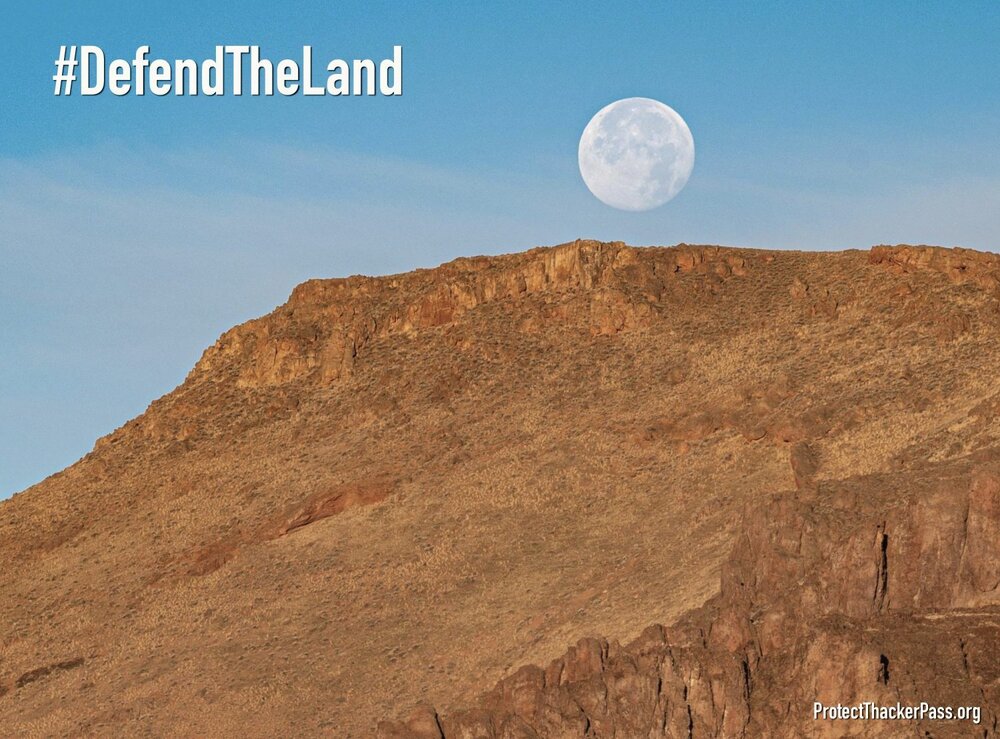In October, DGR conducted an on-the-ground fact finding mission to the sites of two proposed lithium mines in Nevada. In this article, we look at the facts regarding the plans Lithium Nevada company has for mining and processing lithium (mainly destined for making electric car batteries) in northern Nevada, at Thacker Pass.
The company, now with shares owned by a Chinese mining company, claim their open-pit strip-mine will be a “green mine.” Much of this material comes from Thacker Pass. Special thanks to Aimee Wild for collating this material.
Why Lithium?
Lithium is the lightest metal on the periodic table of the elements. It is cost effective. It is an excellent conductor. Lithium batteries power cell phones, laptops and now cars. The batteries are rechargeable and last longer than other batteries. Lithium is also used in heat-resistant glass, ceramics, aircraft metals, lubrication grease, air treatment systems and some pharmaceuticals.
Interest in the mining of lithium as an important commodity is soaring. Lithium is located in the earth’s crust, oceans, mineral springs and igneous rocks. To be able to extract it economically an area, concentrated lithium is needed, hence the interest in the Nevada site. Thousands and thousands of tons of lithium are extracted, processed, transported and utilized every year.
Thacker Pass Mine
Thacker Pass Mine is owned by Lithium Americas. They have a mining project in South America (The Cauchari-Olaroz Project) which is currently under construction, and of course in Nevada, the proposed Thacker Pass mine. Ganfeng (a chinese based mining company) is one of the largest shareholders of Lithium America. This increases the potential for mining and processing to be shipped overseas.
Local communities have struggled to get to the bottom of the plans for the mines. The brochures are complicated and convoluted. What is clear is that the local people have been chosen as a guinea pig. Most Lithium mines in South America involve pumping saltwater brine on barren salt flats where the lithium slowly floats to the top, is skimmed off, and is then purified for use in batteries.
In Australia they use spodumene ore, which is higher quality than the product Lithium Nevada plans to use. There are concerns linked to how the poorer quality lithium will be processed and the transport of chemicals into the processing areas. There are concerns regarding the transportation of refinery waste by rail cars, and shipping. The plans include transporting waste sulfur, by truck to the mine site, where it will be burned and converted to enormous quantities of Sulfuric Acid on a daily basis. Processing (burning) elemental sulfur, creates sulfur dioxide, sulfur trioxide and ultimately sulfuric acid—all of which are toxic and harmful to life.
Radioactive Waste?
There are concerns that the processing of lithium could ‘accidentally’ expose naturally-occurring uranium. Of course there have been promised by the company to ensure that any radioactive waste will be contained by a “liner.” This seems wholly inadequate when considering there is a water source nearby, and processing plants can have accidental fires or explosion. We know from global disasters (Fukoshima and Chernobyl) that the impact environmental disasters involving radioactive waste can devastate human and non-human communities. Transporting chemicals to or from processing plants increase the risk of accidents, and the smell of sulphur in nearby neighborhoods is likely to be overwhelming at times.
Clarity Needed On The Impact Of Thacker Pass Mine
Opposition to these plans are likely to strengthen when the public understand the plans and the potential impact, and when the information is not shrouded in convoluted documents. In short, the mines almost certainly will be destructive to water fowl, to any life in the rivers and lakes nearby, and impact on the water table.
The air quality is likely to reduce, and the storage and transportation of toxic chemicals increases non-intentional leakage/accidents. If understood correctly the plans to dispose of some waste include a tailing pond, which could contain a) toxic solids, b) harmful discharges c) could impact air quality, and d) could leach into ground water. The mining and processing of lithium is destructive to people, non-human life, the land, the water and the air.
Is It Carbon Neutral?
Burning sulfur does not create carbon, so in that respect the facts are correct. However, as with all green capitalist extraction plans this is a small percentage of the whole picture. The whole picture (or the fact based plans) are obscured with overly complex plans and emperors-new-clothes type scenarios. The process of burning sulfur creates harmful (toxic) chemicals and removes oxygen from the atmosphere.
A conservative estimate is that the processing plant will require over 10,000 gallons of diesel per day to run. In additional to this is the fuel needed to transport the sulfur from the refinery (yes; it comes from an oil refinery) to the mine site. You also have the fuel needed to transport the workers and the electricity needed to keep the plant functioning.
There are concerns that the lithium from this project could be shipped to China for processing in the future. Lithium Americas has been loaned substantial amounts of money from Ganfeng and Bangchak. The Chinese Mining company already own shares in Lithium Nevada and could intentionally own more rights if the loan is not paid back.
So, carbon neutral—no. Friendly to the environment—no. There is not much difference between mountaintop removal coal mining and mountaintop removal lithium mining. Both are exceptionally destructive.
You can read more about lithium mines here: www.portectthackerpass.org. Join our newsletter for more info on lithium mining and greenwashing.
